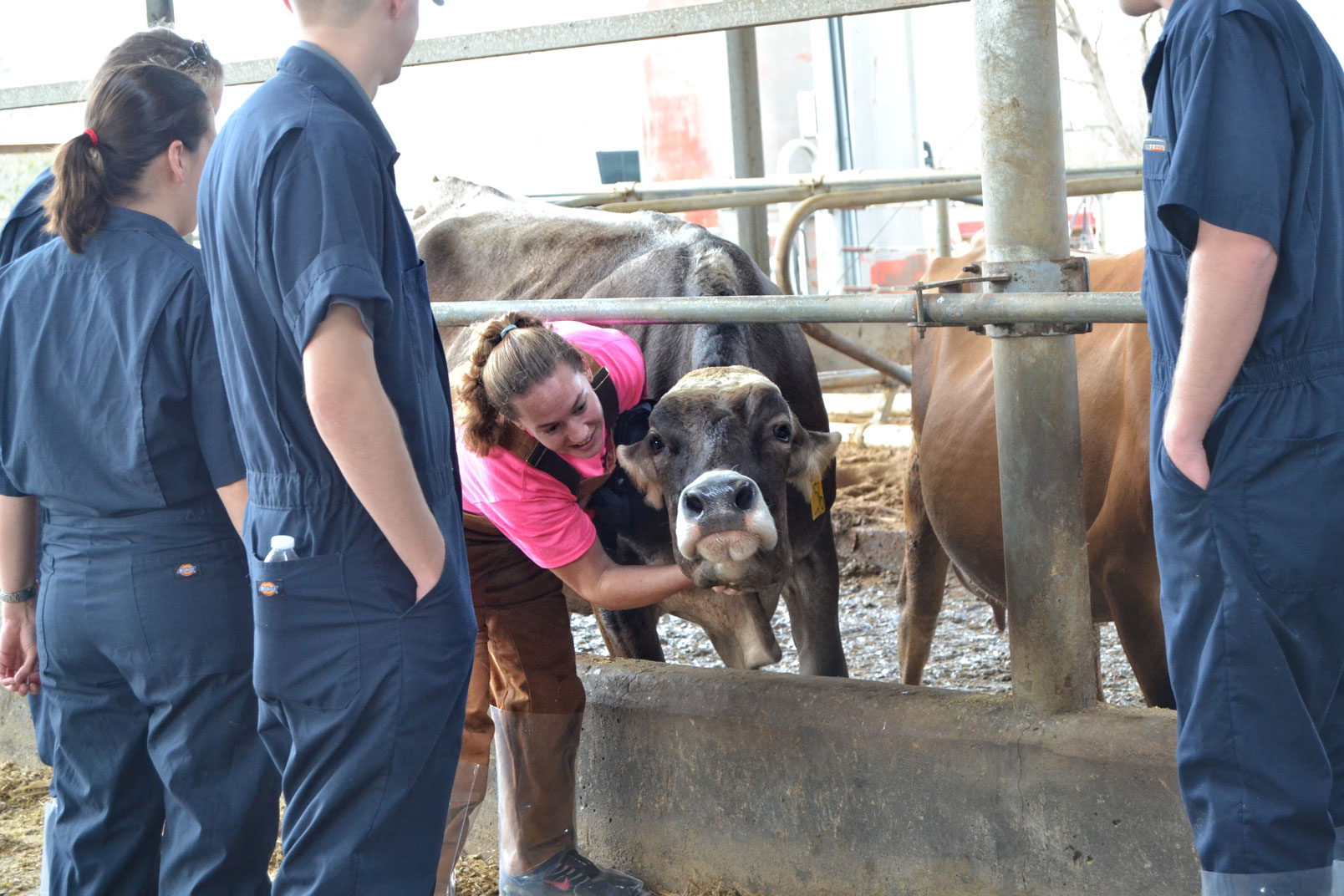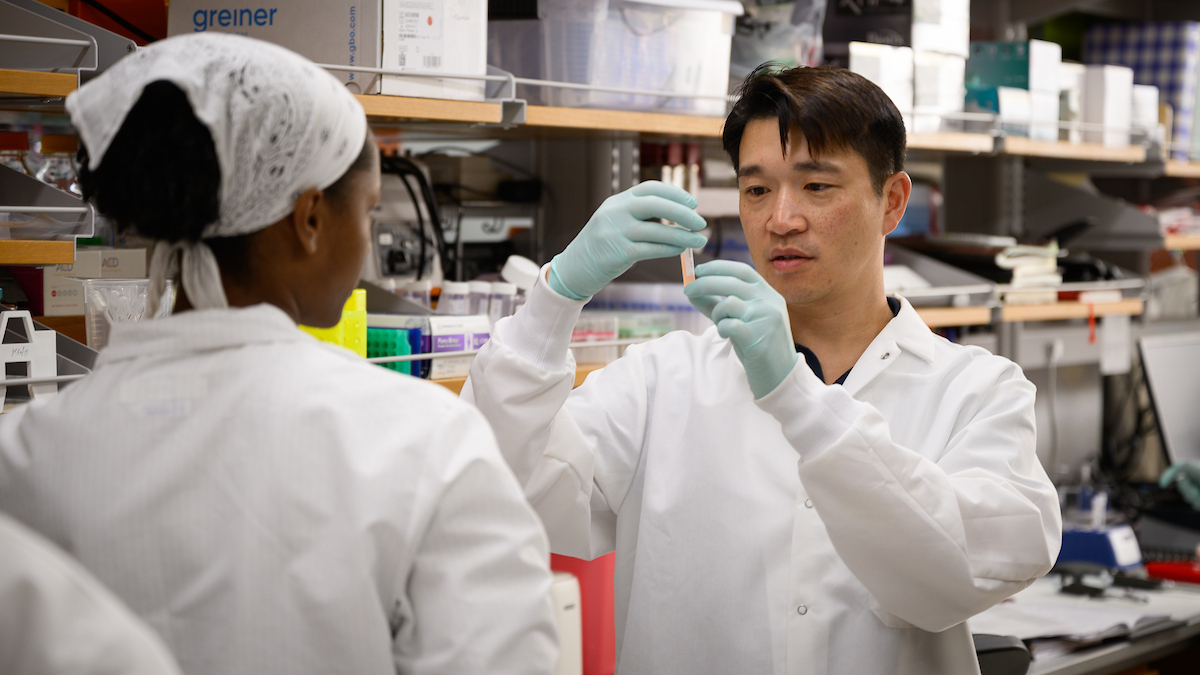Cowabunga’s Incredible Journeys

Harrison Dudley knew he wanted to practice large animal medicine, but he also knew he lacked something very important: hands-on experience.
“I did not grow up around cattle production, so as a student I felt like I had a lot of catching up to do,” he said.
So during his first year at the NC State College of Veterinary Medicine, Dudley used his winter break to take part in the Bovine Educational Symposium, a weeklong immersive experience designed to expose veterinary students to different types of cattle production farms and approaches to farm animal care.
Then he went the next year. And the year after that.
As a student, Dudley visited farms in Pennsylvania, New York, Virginia, Tennessee, Alabama, Mississippi, Georgia and Kentucky. In 2014 and last year, he went on the trips again, this time as an instructor. He’s now CVM’s clinical assistant professor of ruminant health management.
The Bovine Educational Symposium, more popularly — and affectionately — known as Cowabunga, would shape much of Dudley’s educational experience at the CVM, help refine his work in private practice and eventually influence his teaching style.
“My first trip was an eye-opening experience,” said Dudley. “What I didn’t realize at the time was how much those experiences would stick with me … and how they would shape my decisions on case management, ethical standards and even applied techniques.”
Dudley isn’t alone. A new study evaluating Cowabunga’s effectiveness as a teaching tool shows an impact lasting beyond graduation, from learning the nitty-gritty daily life of the cattle industry and understanding biosecurity issues to fine-tuning effective client communication.
“Some of the concepts that students have learned in class can become much more real when they see a farm struggling with a disease that they just learned about,” said Derek Foster, CVM assistant professor of ruminant health and production who co-authored the study.
The study, published by the Journal of Veterinary Medical Education, was completed through pre- and post-trip surveys of more than 100 CVM students who attended Bovine Educational Symposium over three years. Additionally, a group of alumni participated in a group discussion about their experiences. The study was co-authored by Regina Schoenfeld Tacher, CVM associate professor of veterinary education and development and Hannah Sylvester, a research technician in the ruminant medicine and gastrointestinal physiology laboratory.
 Study participants reported far-ranging benefits. Many felt more confident in IDing breeds of cattle and said they have a more complete understanding of bovine production systems. Many said they would be able to apply the knowledge gained about biosecurity and herd health to real-world professional situations. Students said they could model their own client communication on how trip leaders’ effectively interacted with site hosts.
Study participants reported far-ranging benefits. Many felt more confident in IDing breeds of cattle and said they have a more complete understanding of bovine production systems. Many said they would be able to apply the knowledge gained about biosecurity and herd health to real-world professional situations. Students said they could model their own client communication on how trip leaders’ effectively interacted with site hosts.
Strikingly, the trip had a significant impact on the students’ desires to pursue a career in bovine medicine.
The on-site visits are illuminating, but so are the informal moments on the bus traveling from farm to farm. In an open discussion, students share their thoughts about the practices they just saw — the good and the not-so good — and learn from other viewpoints.
“Part of the value of the BES is that we are all on a bus together, eating meals together, visiting farms together for a week,” said Foster. “That breaks down some barriers between classes of students and students and faculty. Students start to feel more comfortable asking questions and offering opinions on some of the challenging topics we discuss, like animal welfare and working with others.”
 Launched in 1989, the Bovine Educational Symposium was designed to provide a real-life experience in production medicine early in veterinary training. On the first trip, 10 students and a faculty member visited farms in Virginia for three days. More than 25 years later, the trip is now a week and usually includes about 50 students and four faculty members.
Launched in 1989, the Bovine Educational Symposium was designed to provide a real-life experience in production medicine early in veterinary training. On the first trip, 10 students and a faculty member visited farms in Virginia for three days. More than 25 years later, the trip is now a week and usually includes about 50 students and four faculty members.
Participation is voluntary; the trip is open to all, not just students with a food-animal focus. The CVM’s student chapter of the American Association of Bovine Practitioners runs and funds the trip. Planning takes a year and the trip has an annual budget of $20,000-$35,000, which is supported by donations from alumni, industry partners and the Fox Family Foundation.
An array of beef and dairy farms are visited. For nearly 30 years, students have crisscrossed the United States, from the feedlots of the Great Plains to the organic dairies of the Northeast. Students have toured Amish and Mennonite farms, drylot dairies of New Mexico and grazing pastures of the Deep South. They talk with real farmers and interact with animals. Often, local veterinarians talk about their roles on the farms.
[pullquote color=”indigo”]“I remember what we talked about because of the technique. It’s a different type of learning. It’s observational learning. It’s in-real-time learning.” Says Kate Bailey[/pullquote]A typical week trip includes more than a dozen stops at farms and dairies, as well as related animal agriculture sites, such as a milk processing plant or livestock auction. When in Mississippi, students explored a catfish farm. In Florida, there was a stop at an alligator farm.
Foster, a 2004 CVM graduate, said the Cowabunga trips are one of his favorite teaching experiences each year. Like Dudley, Foster attended the trips while he was a student and didn’t come from a farm background.
“It was instrumental in me becoming a food animal veterinarian,” said Foster. “Spending a week each year immersed in that environment was critical for me to understand the vocabulary, to see firsthand how farms work and just get comfortable with the industry.”
 And even if a Cowabunga participant is not interested in large animal medicine as a career, the study found that overall those students developed a broader appreciation and understanding of the work of their large-animal vet colleagues.
And even if a Cowabunga participant is not interested in large animal medicine as a career, the study found that overall those students developed a broader appreciation and understanding of the work of their large-animal vet colleagues.
Kate Bailey, a 2009 CVM graduate and now a clinical assistant professor of anesthesiology at the college, went on a Cowabunga trip as a student, visiting farms in Florida. She had never seen a dairy farm.
“That was more than 10 years ago and I still remember the farms,” said Bailey. “I remember what we talked about because of the technique. It’s a different type of learning. It’s observational learning. It’s in-real-time learning.”
Bailey found the interactions with farmers particularly beneficial. She learned what was important to them and what they wanted veterinarians to know about their work. She learned what a comfortable cow looks like and what an uncomfortable cow looks like. She was able to visualize the most beneficial veterinary procedures for each type of farm.
“It really helped give me insight on what treatment plans are feasible and realistic,” said Bailey. “In lectures, we talk about diseases, but we don’t have the opportunity to really talk about what a farmer’s day looks like and actually see what their day is like. You can’t do that in the classroom.”
 Luke Martin was focused on food animal medicine at the CVM with an emphasis on beef cattle. He had already had a good amount of experience within North Carolina’s bovine industry when he went on a Cowabunga trip to Texas and Oklahoma during his first year in school.
Luke Martin was focused on food animal medicine at the CVM with an emphasis on beef cattle. He had already had a good amount of experience within North Carolina’s bovine industry when he went on a Cowabunga trip to Texas and Oklahoma during his first year in school.
Martin, who graduated in 2016, said that going to different types of operations helped him better understand the American cattle industry as a whole. He is now a mixed animal veterinarian practicing in Shelby, N.C., treating small animals, food animals and horses.
“I knew I would get to see a lot of different things, but I did not expect to be able to come away with such useful experiences,” he said. “I have been surprised by how many times I have referenced things I saw and learned on the trip in my own practice here in western North Carolina.”
Dudley is now in his third year teaching at the CVM. He had never intended to become an educator. His Cowabunga trips changed that.
“I believe a lot of my developed skills come from the experiences I had on the Cowabunga bus. It is certainly a model that I carried into this job,” he said. “I am a firm believer in experiential learning. The student experience is much improved if they get to put their hands and eyes on actual examples of the cases they will deal with in their professional careers.”
[highlight color=”gray”] [fa_icon name=”fa-picture-o” size=”1x”] Cowabunga Photo Gallery
[awesome-gallery id=546201]
[/highlight]
~Jordan Bartel/NC State Veterinary Medicine


